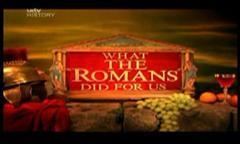7.4 /10 1 Votes7.4
6.2/10 TV Directed by Inge Samuels Country of origin United Kingdom No. of episodes 6 Final episode date 11 December 2000 Language English | 8.5/10 IMDb Genre Documentary Original language(s) English First episode date 6 November 2000 | |||||||||||||||||||||||||||||||||
 | ||||||||||||||||||||||||||||||||||
Similar What the Ancients Did for Us, What the Victorians Did for Us, What the Tudors Did for Us, Ancient Rome: The Rise and, Ancient Inventions | ||||||||||||||||||||||||||||||||||
What the Romans Did for Us, is a 2000 BBC documentary series "looking at the innovations and inventions brought to Britain by the Romans". The title of the programme is derived from the cult movie Monty Python's Life of Brian, referencing the famous scene where the People's Front of Judea discuss "What have the Romans done for us?"
Contents
- What the romans did for us life of luxury ep 1 bbc
- Production
- Awards
- Episodes
- Episode one Life of Luxury
- Episode two Invasion
- Episode three Building Britain
- Episode four Arteries of the Empire
- Episode five Edge of Empire
- Episode six Ahead of Their Time
- References
What the romans did for us life of luxury ep 1 bbc
Production
In 2003, the series was re-edited into 10-minute sections for broadcast as programme fillers.
Awards
Nominated for Best Feature at the British Academy Television Awards 2001.
Episodes
These are the White Cliffs of Dover, and this must have been the first bit of Britain that the Romans saw when they came to invade. In fact they came in force in about May of AD 43. That wasn’t the first time they had visited the islands because Julius Caesar had come over a hundred years earlier, but he only stayed for a few weeks. In AD 43 the Romans meant to stay.
Episode one: Life of Luxury
After hundreds of years of occupation many generations of people in Britain had grown up surrounded by Roman culture, and after a long period of stability that culture was showing visible signs of wealth, success and good living.
Episode two: Invasion
In this series I’m going to see what the Romans brought with them and what they left behind when finally they went home 400 years later. Why did they come? Well, partly for the glory, partly for the farmland, and for the minerals like copper, lead and gold, and simply to trade. We'll be returning to those things later in the series, but for the moment lets see how they established their first foothold.
Episode three: Building Britain
Within 30 years of the invasion there were 60,000 Roman troops in Britain, they had come from some of the most advanced places in Europe, and to them this sort of settlement must have seemed primitive. This is the story of how they transformed the landscape and laid the foundations for the countryside and the cities that we have today.
Episode four: Arteries of the Empire
When Britain became Roman the Britons gained access to the finest goods the Empire could offer. The Roman economy was fuelled by trade, but they had trouble meeting the demand for luxury goods like jewellery. What they needed was the raw materials, the ores, and that is one of the principal reasons that the Romans came to Britain and stayed here for 400 years, but this trade would have been impossible without their amazing network of roads.
Episode five: Edge of Empire
The Roman Army took nearly 50 years to work their way up, through their new province, to what is now Scotland. But they never really conquered these northern tribes, and they remained a thorn in the flesh of Roman Britain. By about AD 120, the northern frontier ranged from Wallsend in the east, to Carlisle in the west, and the emperor Hadrian said, "Build a wall, and keep all the others out." This remains the best known frontier anywhere in the Roman world, and it's the perfect place from which to contemplate life at the edge of empire.
Episode six: Ahead of Their Time
The Romans ruled Britain for nearly four hundred years. They brought with them all sorts of revolutionary new concepts, from the hot bath to the hamburger. In this programme, I'm going to look at some of their wackier technology, like the first robot, and the slot machine; inventions that were literally centuries ahead of their time.
